戴尔科技云原生存储解决方案白皮书_20200422
- 格式:pdf
- 大小:1015.15 KB
- 文档页数:10
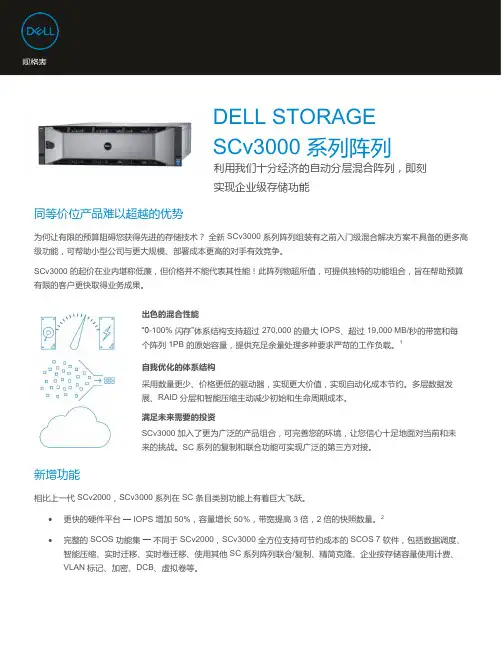
规格表DELL STORAGESCv3000 系列阵列利用我们十分经济的自动分层混合阵列,即刻实现企业级存储功能同等价位产品难以超越的优势为何让有限的预算阻碍您获得先进的存储技术? 全新 SCv3000 系列阵列组装有之前入门级混合解决方案不具备的更多高级功能,可帮助小型公司与更大规模、部署成本更高的对手有效竞争。
SCv3000 的起价在业内堪称低廉,但价格并不能代表其性能!此阵列物超所值,可提供独特的功能组合,旨在帮助预算有限的客户更快取得业务成果。
出色的混合性能“0-100% 闪存”体系结构支持超过 270,000 的最大 IOPS 、超过 19,000 MB/秒的带宽和每个阵列 1PB 的原始容量,提供充足余量处理多种要求严苛的工作负载。
1自我优化的体系结构采用数量更少、价格更低的驱动器,实现更大价值,实现自动化成本节约。
多层数据发展、RAID 分层和智能压缩主动减少初始和生命周期成本。
满足未来需要的投资SCv3000 加入了更为广泛的产品组合,可完善您的环境,让您信心十足地面对当前和未来的挑战。
SC 系列的复制和联合功能可实现广泛的第三方对接。
新增功能相比上一代 SCv2000,SCv3000 系列在 SC 条目类别功能上有着巨大飞跃。
∙更快的硬件平台 — IOPS 增加 50%,容量增长 50%,带宽提高 3 倍,2 倍的快照数量。
2 ∙ 完整的 SCOS 功能集 — 不同于 SCv2000,SCv3000 全方位支持可节约成本的 SCOS 7 软件,包括数据调度、智能压缩、实时迁移、实时卷迁移、使用其他 SC 系列阵列联合/复制、精简克隆、企业按存储容量使用计费、VLAN 标记、加密、DCB 、虚拟卷等。
EMC 集成— VMware 支持、PowerPath、Data Domain、RecoverPoint、Networker、VPLEX、ViPR 和全新CloudIQ 基于云的分析。
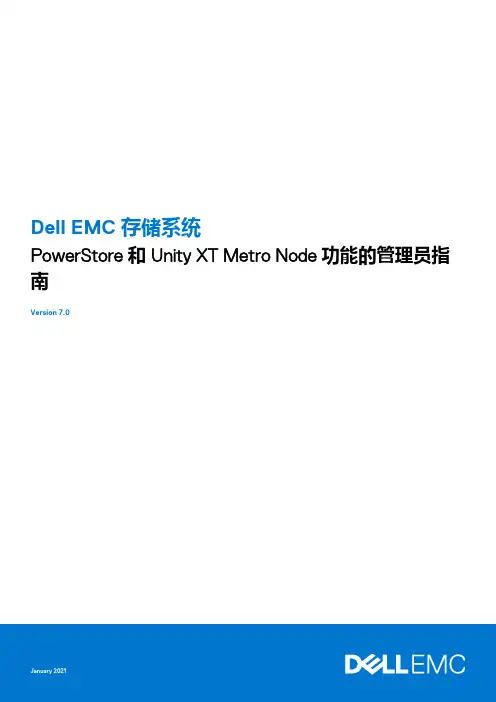
Dell EMC 存储系统PowerStore 和 Unity XT Metro Node 功能的管理员指南Version 7.0注意、小心和警告:“注意”表示帮助您更好地使用该产品的重要信息。
:“小心”表示可能会损坏硬件或导致数据丢失,并告诉您如何避免此类问题。
:“警告”表示可能会导致财产损失、人身伤害甚至死亡。
版权所有 © 2020 2021 Dell Inc. 或其子公司。
保留所有权利。
Dell、EMC、Dell EMC 和其他商标为 Dell Inc. 或其子公司的商标。
Dell® / EMC® / Dell EMC® 等品牌商标将有可能同时出现在戴尔易安信相关企业级产品 (包括硬件和软件),和/或产品资料、戴尔易安信的官方网站。
如果您有有关戴尔易安信产品相关的任何疑问,欢迎联系您的指定客户经理。
其他商标可能是其各自所有者的商标。
章 1: CLI 工作区和用户帐户 (7)配置 CLI 工作区 (7)设置控制台日志记录的阈值 (7)将窗口宽度设置为 100 (8)上下文树搜索 (8)章 2: 元数据卷 (9)关于元数据卷 (9)元数据卷性能和可用性要求 (9)移动元数据卷 (10)重命名元数据卷 (10)删除元数据卷 (11)显示元数据卷 (11)验证元数据卷的一致性 (13)章 3: 系统管理 (14)Call Home 通知 (14)关于 Call Home 通知 (14)其他文档 (15)事件日志位置 (15)通过 VAAI 进行硬件加速 (15)Compare and Write (16)WriteSame (16) (18)启用/禁用 WriteSame (16) (18)使用 XCOPY 减少拷贝开销 (19)使用 CLI 启用和禁用 XCOPY (19)显示 XCOPY 统计信息 (20)重命名 Metro Node 群集 (20)LCD 前面板设置 (21)章 4: Metro Node 中的精简支持 (22)Metro Node 中的精简支持 (22)精简资源调配 (23)创建支持精简功能的虚拟卷 (23)更改虚拟卷的精简特性 (24)精简存储管理 (25)精简镜像和迁移 (26)执行精简镜像 (26)关于精简迁移 (27)章 5: 调配存储资源 (28)资源调配概述 (28)使用 EZ 资源调配来调配存储资源 (28)目录3章 6: 卷扩展 (30)概述 (30)其他文档 (30)卷扩展方法 (30)使用 CLI 列出 expansion-method 属性 (30)使用 Unisphere 列出 expansion-method 属性 (31)扩展虚拟卷 (32)存储卷扩展方法 (32)限制 (34)章 7: 数据迁移 (36)关于数据迁移 (36)一次性迁移 (36)限制 (36)批量迁移 (36)执行数据迁移的常规步骤 (36)迁移支持精简功能的存储 (37)关于重建 (40)为经过精简资源调配的存储重建 (40)性能注意事项 (41)一次性数据迁移 (41)启动一次性设备迁移 (41)监视迁移的进度 (42)暂停/恢复迁移(可选) (43)取消迁移(可选) (43)提交已完成的迁移 (44)清理迁移 (44)删除迁移记录 (44)批量迁移 (45)前提条件 (45)创建批量迁移计划 (45)检查批量迁移计划 (45)修改批量迁移文件 (46)启动批量迁移 (46)暂停/恢复批量迁移(可选) (47)取消批量迁移(可选) (47)监视批量迁移的进度 (47)查看批量迁移的状态 (48)提交批量迁移 (48)清理批量迁移 (49)删除批量迁移记录 (49)章 8: 配置 WAN 网络 (50)Metro Node 硬件和 WAN 端口 (50)基于 IP WAN 的 Metro 端口配置规则 (50)端口组 (50)CLI 上下文 (50)4目录/connectivity/back-end/ (53)/connectivity/front-end/ (53)/connectivity/local-com/ (53)管理和监视后端网络 (53)从服务中排除具有高延迟的后端 IT Nexus (54)由于性能不稳定,将后端 IT Nexus 标记为隔离 (54)LDAP (55)目录结构 (55)示例(ldapsearch 命令) (55)章 9: 一致性组 (57)关于 Metro Node 一致性组 (57)同步一致性组 (57)一致性组的属性 (60)可见性 (60)Storage-at-clusters (61)分离规则 (61)Auto-resume-at-loser (62)Virtual-volumes (63)管理一致性组 (63)创建一致性组 (63)将卷添加到一致性组 (65)从一致性组中删除卷 (65)修改一致性组属性 (66)修改示例:设置可见性 (67)修改示例:应用分离规则 (68)删除一致性组 (68)显示一致性组属性 (69)操作一致性组 (73)回滚后恢复 I/O (74)在失败群集上恢复 I/O (75)设置只读属性 (76)章 10: 性能和监控 (78)关于性能 (78)RPO 和 RTO (78)关于性能监控 (78)使用适用于 Metro Node 的 Unisphere 进行性能监控 (79)使用 Metro Node CLI 进行性能监控 (80)使用 CLI 监视性能 (80)关于文件轮换和时间戳 (80)过程概述:使用 CLI 创建监控器 (81)创建监控器 (82)添加/删除监视接收器 (82)删除监控器 (84)启用/禁用/更改轮询 (86)启用/禁用接收器 (87)目录5入门 (87)设置用于通过电子邮件发送报告的脚本 (88)检查脚本状态 (88)调整阈值(如果需要) (89)端口统计信息监视用途信息 (89)输出示例 (90)需要注意的内容 (91)统计信息 (92)显示可用统计信息 (92)前端性能统计信息 (93)统计信息表 (94)附录 A: 具有主动-被动存储阵列的 Metro Node (104)主动-被动阵列 (104)已启用 ALUA 模式的阵列 (104)逻辑单元故障切换执行 (104)逻辑单元故障恢复 (105)索引 (106)6目录1CLI 工作区和用户帐户本章介绍如何使用 Metro Node 命令行界面 (CLI) 配置 CLI 工作区和管理用户帐户。

EMC存储基础知识白皮书目录第1章网络存储主要技术 (3)1。
1 概述 (3)1。
2 DAS:直接附加存储 (3)1。
3 SAN:存储区域网络 (4)1。
3.1 什么是SAN? (4)1。
3.2 SAN的误区 (4)1.3。
3 SAN的组成 (5)1.3。
4 FC SAN的问题 (5)1.3。
5 IP SAN (6)1。
4 NAS:网络附加存储 (7)1。
5 SAN和NAS (8)第2章主要协议和相关技术 (9)2.1 SCSI (9)2。
2 FC(光纤通道) (9)2。
3 iSCSI (10)2.4 iSCSI与光纤通道的比较 (11)第3章文件系统相关知识 (13)3。
1 什么是文件系统 (13)3.2 主流文件系统和特点 (13)3。
3 NFS和CIFS网络文件系统工作原理和特点 (17)3。
4 存储系统与文件系统的关系 (18)第4章 RAID技术 (18)4.1 RAID概述 (18)4.2 RAID级别 (18)4.2.1 RAID0 (19)4。
2.2 RAID1 (19)4.2。
3 RAID2 (20)4。
2。
4 RAID3 (20)4.2.5 RAID4 (21)4.2.6 RAID5 (21)4.2。
7 RAID6 (22)4。
2。
8 RAID10 (23)4。
2。
9 RAID01 (23)4.2.10 JBOD (24)4.3 不同RAID级别对比 (24)第1章网络存储主要技术1.1 概述存储系统是整个IT系统的基石,是IT技术赖以存在和发挥效能的基础平台。
早先的存储形式是存储设备(通常是磁盘)与应用服务器其他硬件直接安装于同一个机箱之内,并且该存储设备是给本台应用服务器独占使用的。
随着服务器数量的增多,磁盘数量也在增加,且分散在不同的服务器上,查看每一个磁盘的运行状况都需要到不同的应用服务器上去查看。
更换磁盘也需要拆开服务器,中断应用。
于是,一种希望将磁盘从服务器中脱离出来,集中到一起管理的需求出现了。
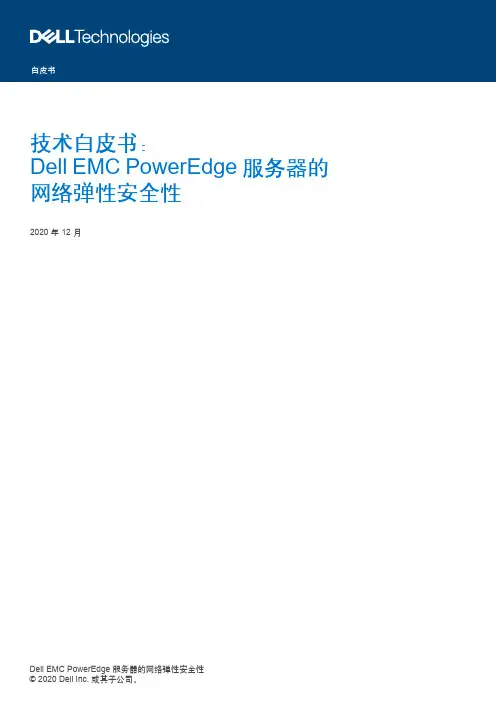
技术白皮书:Dell EMC PowerEdge 服务器的网络弹性安全性2020 年 12 月修订记录本出版物的内容按“原样”提供。
Dell Inc. 对本出版物的内容不提供任何形式的陈述或担保,明确拒绝对适销性或针对特定目的的适用性进行默示担保。
需具备适用的软件许可证才能使用、复制和分发本出版物中说明的任何软件。
版权所有 © 2018 Dell Inc. 或其子公司。
保留所有权利。
Dell、EMC 和其他商标是 Dell Inc. 或其子公司的商标。
其他商标可能是其各自所有者的财产。
中国印刷 [11/12/20] [技术白皮书]信息如有更改,恕不另行通知。
1.简介 (5)2.通向安全服务器基础架构之路 (6)2.1 安全开发生命周期 (6)2.2 网络弹性体系结构 (7)2.3 当今的威胁 (7)3.保护 (8)3.1 经过加密验证的可信启动 (8)3.1.1 基于硅的信任根 (8)3.1.2 BIOS 实时扫描 (10)3.1.3 UEFI 安全启动自定义 (10)3.1.4 TPM 支持 (10)3.1.5 安全认证 (10)3.2 用户访问安全性 (11)3.2.1 RSA SecurID MFA (11)3.2.2 简化的 2FA (11)3.2.3 SELinux 框架 (12)3.2.4 最低限度权限 (12)3.2.5 自动证书登记和续订 (12)3.2.6 出厂默认密码 (13)3.2.7 动态系统锁定 (13)3.2.8 域隔离 (13)3.3 签名固件更新 (13)3.4 加密数据存储 (14)3.4.1 iDRAC 凭证存储区 (14)3.4.2 本地密钥管理 (LKM) (14)3.4.3 Secure Enterprise key Manager (SEKM) (15)3.5 硬件安全性 (15)3.5.1 机箱防盗警报 (15)3.5.2 动态 USB 端口管理 (15)3.5.3 iDRAC Direct (16)3.5.4 带地理位置的 iDRAC 连接视图 (16)3.6 供应链完整性和安全性 (16)3.6.1 硬件和软件完整性 (17)3.6.2 物理安全性 (17)3.6.3 专为 PowerEdge 服务器设计的 Dell Technologies Secured Component Verification (SCV) (17)4.1 通过 iDRAC 进行全面监控 (18)4.1.1 生命周期日志 (18)4.1.2 警报 (18)4.2 偏差检测 (19)5.恢复 (20)5.1 对新漏洞的快速响应 (20)5.2 BIOS 和操作系统恢复 (20)5.3 固件回滚 (21)5.4 硬件维修后恢复服务器配置 (21)5.4.1 部件更换 (21)5.4.2 Easy Restore(适用于主板更换) (22)5.5 系统擦除 (22)5.6 iDRAC9 密码选择 (23)5.7 CNSA 支持 (23)5.8 完整电源周期 (23)6.摘要 (24)A. 附录:延伸阅读 (25)1.简介随着威胁环境的不断发展,IT 和安全专业人员在管理数据和资源风险方面日益艰难。
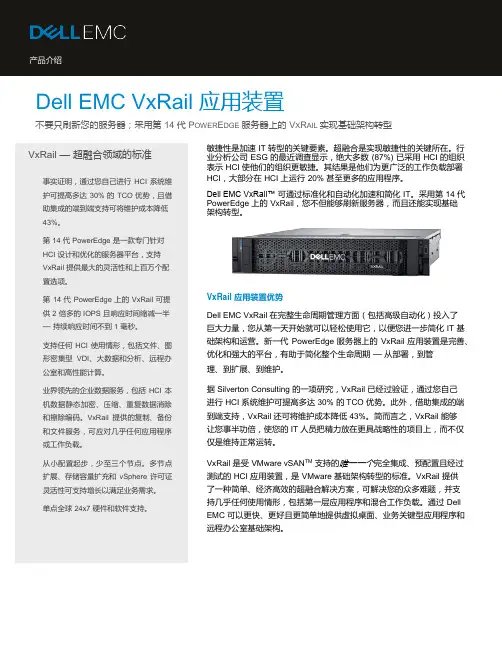
产品介绍Dell EMC VxRail 应用装置不要只刷新您的服务器;采用第 14 代 P OWER E DGE 服务器上的 V X R AIL 实现基础架构转型 敏捷性是加速 IT 转型的关键要素。
超融合是实现敏捷性的关键所在。
行业分析公司 ESG 的最近调查显示,绝大多数 (87%) 已采用 HCI 的组织表示 HCI 使他们的组织更敏捷。
其结果是他们为更广泛的工作负载部署 HCI ,大部分在 HCI 上运行 20% 甚至更多的应用程序。
Dell EMC VxRail™ 可通过标准化和自动化加速和简化 IT 。
采用第 14 代PowerEdge 上的 VxRail ,您不但能够刷新服务器,而且还能实现基础架构转型。
VxRail 应用装置优势 Dell EMC VxRail 在完整生命周期管理方面(包括高级自动化)投入了巨大力量,您从第一天开始就可以轻松使用它,以便您进一步简化 IT 基础架构和运营。
新一代 PowerEdge 服务器上的 VxRail 应用装置是完善、优化和强大的平台,有助于简化整个生命周期 — 从部署,到管 理、到扩展、到维护。
据 Silverton Consulting 的一项研究,VxRail 已经过验证,通过您自己进行 HCI 系统维护可提高多达 30% 的 TCO 优势。
此外,借助集成的端到端支持,VxRail 还可将维护成本降低 43%。
简而言之,VxRail 能够让您事半功倍,使您的 IT 人员把精力放在更具战略性的项目上,而不仅仅是维持正常运转。
VxRail 是受VMware vSAN TM 支持的唯一一个完全集成、预配置且经过测试的 HCI 应用装置,是 VMware 基础架构转型的标准。
VxRail 提供了一种简单、经济高效的超融合解决方案,可解决您的众多难题,并支持几乎任何使用情形,包括第一层应用程序和混合工作负载。
通过 DellEMC 可以更快、更好且更简单地提供虚拟桌面、业务关键型应用程序和远程办公室基础架构。

研发运营安全白皮书(2020年)云计算开源产业联盟OpenSource Cloud Alliance for industry,OSCAR2020年7月前言近年来,安全事件频发,究其原因,软件应用服务自身存在代码安全漏洞,被黑客利用攻击是导致安全事件发生的关键因素之一。
随着信息化的发展,软件应用服务正在潜移默化的改变着生活的各个方面,渗透到各个行业和领域,其自身安全问题也愈发成为业界关注的焦点。
传统研发运营模式之中,安全介入通常是在应用系统构建完成或功能模块搭建完成之后,位置相对滞后,无法完全覆盖研发阶段的安全问题。
在此背景下,搭建整体的研发运营安全体系,强调安全左移,覆盖软件应用服务全生命周期安全,构建可信理念是至关重要的。
本白皮书首先对于研发运营安全进行了概述,梳理了全球研发运营安全现状,随后对于信通院牵头搭建的研发运营安全体系进行了说明,归纳了研发运营安全所涉及的关键技术。
最后,结合当前现状总结了研发运营安全未来的发展趋势,并分享了企业组织研发运营安全优秀实践案例以供参考。
参与编写单位中国信息通信研究院、华为技术有限公司、深圳市腾讯计算机系统有限公司、阿里云计算有限公司、浪潮云信息技术股份公司、京东云计算(北京)有限公司、北京金山云网络技术有限公司、深圳华大生命科学研究院、奇安信科技集团股份有限公司、杭州默安科技有限公司、新思科技(上海)有限公司主要撰稿人吴江伟、栗蔚、郭雪、耿涛、康雪婷、徐毅、章可镌、沈栋、郭铁涛、张祖优、马松松、黄超、伍振亮、祁景昭、朱勇、贺进、宋文娣、张娜、蔡国瑜、张鹏程、张玉良、董国伟、周继玲、杨国梁、肖率武、薛植元目录一、研发运营安全概述 (1)(一)研发层面安全影响深远,安全左移势在必行 (1)(二)覆盖软件应用服务全生命周期的研发运营安全体系 (4)二、研发运营安全发展现状 (5)(一)全球研发运营安全市场持续扩大 (5)(二)国家及区域性国际组织统筹规划研发运营安全问题 (7)(三)国际标准组织及第三方非盈利组织积极推进研发运营安全共识 (12)(四)企业积极探索研发运营安全实践 (14)(五)开发模式逐步向敏捷化发展,研发运营安全体系随之向敏捷化演进 (19)三、研发运营安全关键要素 (21)(一)覆盖软件应用服务全生命周期的研发运营安全体系 (22)(二)研发运营安全解决方案同步发展 (31)四、研发运营安全发展趋势展望 (41)附录:研发运营安全优秀实践案例 (43)(一)华为云可信研发运营案例 (43)(二)腾讯研发运营安全实践 (50)(三)国家基因库生命大数据平台研发运营安全案例 (58)图目录图1 Forrester外部攻击对象统计数据 (2)图2研发运营各阶段代码漏洞修复成本 (3)图3 研发运营安全体系 (4)图4 Cisco SDL体系框架图 (16)图5 VMware SDL体系框架图 (17)图6 微软SDL流程体系 (20)图7 DevSecOps体系框架图 (21)图8 研发运营安全解决方案阶段对应图 (32)表目录表1 2019-2020全球各项安全类支出及预测 (6)表2 2019-2020中国各项安全类支出及预测 (7)表3 重点国家及区域性国际组织研发运营安全相关举措 (12)表4 国际标准组织及第三方非营利组织研发运营安全相关工作 (14)表5 企业研发运营安全具体实践 (19)表6 SDL与DevSecOps区别对照 (21)一、研发运营安全概述(一)研发层面安全影响深远,安全左移势在必行随着信息化的发展,软件应用服务正在潜移默化的改变着生活的各个方面,渗透到各个行业和领域,软件应用服务的自身安全问题也愈发成为业界关注的焦点。
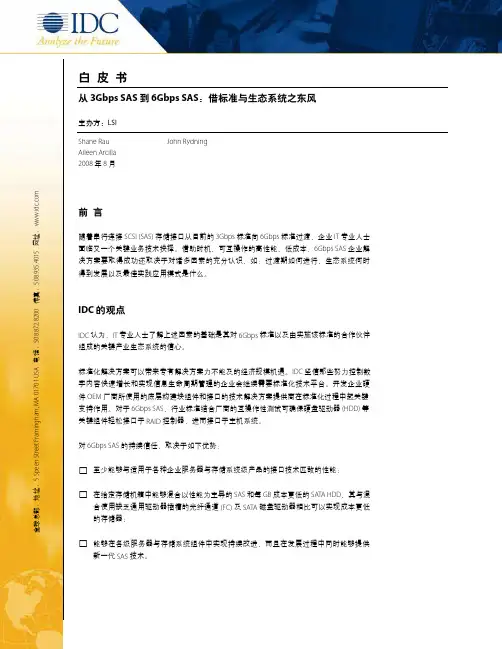

vxrail白皮书VxRail是一种基于VMware软件定义技术和Dell EMC硬件的超融合基础设施解决方案。
它的设计旨在提供简单、高效和强大的IT基础设施,以支持企业的现代化工作负载。
本白皮书将介绍VxRail超融合基础设施的架构、功能和优势。
我们将详细解释VxRail超融合基础设施的关键技术和组件,并探讨它如何提供高性能、可靠性和弹性,以满足企业不断增长的需求。
VxRail超融合基础设施是由计算、存储和网络组件组成的一体化解决方案。
它采用了软件定义存储(SDS)和软件定义网络(SDN)技术,以提供高度集成的虚拟化环境。
在VxRail超融合基础设施中,计算节点由多个物理服务器组成,每个服务器配有强大的多核处理器、大内存容量和高速存储驱动器。
这些计算节点共享统一存储池,以提供高吞吐量和低延迟的存储性能。
VxRail超融合基础设施采用了高度自动化的管理平台,用于部署、监视和维护整个基础设施。
管理员可以通过这个平台进行集中管理,并轻松实现资源弹性伸缩和自动化操作。
VxRail超融合基础设施的主要功能包括:1. 高性能:VxRail采用了最新的硬件技术和优化的软件算法,以提供卓越的计算和存储性能。
它支持高密度虚拟机部署和密集的I/O工作负载,可以满足企业的高性能需求。
2. 可靠性:VxRail具有多层次的数据保护功能,包括快照、备份和容灾技术。
它可以提供高可用性和灾难恢复能力,确保企业的数据始终安全可靠。
3. 弹性:VxRail超融合基础设施具有良好的扩展性和灵活性。
企业可以根据需要扩展计算和存储资源,以适应不断增长的工作负载。
4. 简化管理:VxRail提供了一套直观、易用的管理工具,使管理员能够轻松地配置、监视和维护整个基础设施。
它还支持自动化操作,可以大大减少日常管理工作量。
5. 兼容性:VxRail完全兼容VMware软件定义技术,包括vSphere、vSAN和NSX等。
它还与Dell EMC的其他解决方案集成,包括备份和恢复、复制和数据保护等。
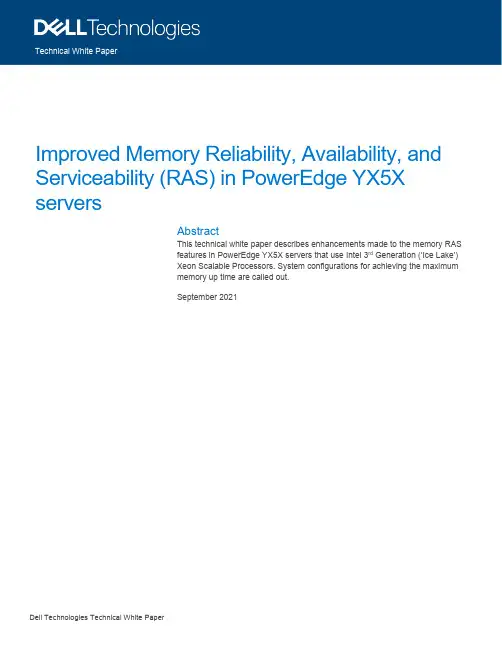
Technical White PaperImproved Memory Reliability, Availability, and Serviceability (RAS) in PowerEdge YX5X serversAbstractThis technical white paper describes enhancements made to the memory RASfeatures in PowerEdge YX5X servers that use Intel 3rd Generation (‘Ice Lake’)Xeon Scalable Processors. System configurations for achieving the maximummemory up time are called out.September 2021RevisionsAcknowledgementsAuthor(s): Jordan Chin (Memory Systems Engineering)Support: Mark Dykstra (Escalation Engineering), Kevin Cross (Memory Systems Engineering), Dave Chalfant(BIOS Engineering), Rene Franco (Memory Systems Engineering), and Trent Bates (Product Management)Others: Sheshadri PR Rao (InfoDev)The information in this publication is provided “as is.” Dell Inc. makes no representations or warranties of any kind with re spect to the information in this publication, and specifically disclaims implied warranties of merchantability or fitness for a particular purpose.Use, copying, and distribution of any software described in this publication requires an applicable software license.Copyright © 2021 Dell Inc. or its subsidiaries. All Rights Reserved. Dell Technologies, Dell, EMC, Dell EMC and other trademarks are trademarks of Dell Inc. or its subsidiaries. Other trademarks may be trademarks of their respective owners. [9/13/2021] [Technical White Paper] [Manager]Contents Revisions (2)Acknowledgements (2)Contents (3)Executive Summary (4)1RAS improvements in the Chipset (5)1.1Intel Partial Cache Line Sparing (PCLS) (5)1.2Improvements to Advanced ECC (or Single Device Data Correction) (5)2Smarter Self-healing (6)2.1Memory Health Check (6)2.2Self-healing during Full-Boot Memory tests (7)3Other Memory Serviceability improvements (9)3.1Redesigned Memory Event messaging (9)3.1.1Standard Memory Event Message severity levels (9)3.1.2Prescriptive Remediation (9)3.2User-directed Memory Map-out (10)4Legacy RAS features (12)5Achieving Maximum Memory Uptime (13)6Applicable PowerEdge YX5X servers (14)Executive SummaryExecutive SummaryIn our Memory Errors and Dell EMC PowerEdge YX4X Server Memory RAS Features technical white paper,we provided a primer on memory errors and the Memory Reliability, Availability, and Serviceability (RAS)features on our PowerEdge YX4X products. Most of the principles and RAS feature information from thatwhitepaper continue to remain intact for our latest YX5X line of PowerEdge products. However, as with everygeneration of Dell EMC PowerEdge server product, we continue to innovate and improve. With thisdocument, we would like to share with our customers the next generation of improvements to the memoryRAS capabilities in our latest YX5X line of PowerEdge products. At a high-level, this includes the followingnew features or processes:The content covered in this technical white paper applies only to DRAM based memory modules and does not apply to Intel Optane Persistent Memory. Also, this content is specific to Dell EMC PowerEdge YX5X serverswith 3rd generation Intel Xeon Scalable Processors.RAS improvements in the Chipset1 RAS improvements in the ChipsetIntel introduced the following improvements in their third generation of Xeon Scalable Processors:1.1 Intel Partial Cache Line Sparing (PCLS)The third generation of Xeon Scalable Processors contains 16 segments of spare cachelines per DDR channel in their integrated Memory Controllers (iMC). When BIOS detectsthat DRAM on a DIMM is experiencing single-bit errors (SBEs) for a particular cache line,it may request the iMC to re-map the offending portion of the cache-line to use its internalspare cache instead. Single-bit errors are generally harmless, but if left unchecked, theycould cause unwanted activation of preventative RAS features that can impact systemperformance.This feature will prevent continued triggering of the Dell Predictive Failure Algorithm (PFA) that wouldotherwise activate other RAS features (such as ADDDC) or consume self-healing resources. This results infewer performance impacts and corrective actions required by users. This feature is available on all third GenXeon Scalable Processors. There are no memory or system configuration requirements necessary to takeadvantage of PCLS.1.2 Improvements to Advanced ECC (or Single Device Data Correction)Intel has redesigned and optimized their Advanced Error Correcting Code in 3rd Gen XeonScalable Processors to handle the most common failure patterns known among the majorDRAM suppliers. In doing this, many of the multi-bit error patterns that were uncorrectable byprevious generations of Intel Xeon Scalable Processors are now correctable by 3rd GenXeon SPs. This uplift will result in a significant decrease in uncorrectable memory errors.This enhancement is available on all 3rd Gen Xeon Scalable Processors. There are no memory or systemconfiguration requirements necessary to take advantage of the improved Advanced ECC (or SDDC).For more information about Advanced ECC, see the Memory Errors and Dell EMC PowerEdge YX4X ServerMemory RAS Features technical white paper available on the Dell support site.2 Smarter Self-healingDell Technologies has introduced Memory Health Check and self-healing on full-boots as improvements tomemory self-healing in their PowerEdge YX5X servers. When used together, these features should provide amultiplicative effect on the testing and self-healing coverage for memory while minimally impacting the serverboot time.2.1 Memory Health CheckPrevious Dell EMC PowerEdge implementations of memory self-healing was based ontargeting repairs at a specific memory location where an uncorrectable error or multiplecorrectable errors were detected. For self-healing to take effect, the system must berebooted—thereby, resulting in some downtime. Understanding that downtime can beimpactful and difficult to arrange, it made sense to make use of any downtime because ofself-healing and use it as an opportunity to find other questionable memory locations and repair them. Thiswould prevent the need for future reboot operations and downtime to conduct further self-healing. Thus, DellTechnologies has developed Memory Health Check.Dell Memory Health Check works by first allowing the original self-healing process to execute and completeas described in the original Memory Errors and Dell EMC PowerEdge YX4X Server Memory RAS Featurestechnical white paper. Next, during the same boot cycle as the original self-heal, BIOS executes rigoroustesting throughout the DRAM rank where memory errors have occurred. The rigorous testing used by DellMemory Health Check is the same used by the Dell factory memory screening process. BIOS on thePowerEdge server can quickly and efficiently execute this type of rigorous testing (which can normally takehours) by intelligently testing the affected DRAM rank instead of the entire system memory range.Figure 1 The Memory Health Check process in PowerEdge YX5X serversLastly, if any additional questionable locations are found by this enhanced screening, then those locations are automatically repaired within the same boot cycle, thereby incurring no additional reboot penalty.If BIOS detects that there are more questionable locations than there are self-healing resources available torepair them, then BIOS will automatically map-out that memory region and message to the user that a DIMMreplacement is necessary.The execution of Dell Memory Health Check adds several seconds of boot time and is only executed asneeded based on certain types of memory health events from the previous boot. Normal boots should not see an impact to completion time.This feature is available on all 3rd Gen Xeon Scalable Processors. There are no memory or systemconfiguration requirements necessary to take advantage of Dell Memory Health Check.2.2 Self-healing during Full-Boot Memory testsOn Dell EMC PowerEdge platforms, the default boot behavior is ‘fast boot’, where the DDRbus is trained only partially and memory testing phase is skipped. ‘Full-boot’ is executedafter either a BIOS upgrade, memory configuration change, or after a memory health event(such as uncorrectable error or large number of correctable errors) or the system isconfigured to do so. During a full-boot cycle, BIOS performs memory retraining and a quickmemory test among other activities.On PowerEdge YX5X servers, Dell Technologies has added the ability to perform self-healing based on theresults of this quick memory test which differs from the testing in Memory Health Check in the following ways:Despite the differences in testing, the self-healing and map-out functions of the two features are identical. Ifany questionable locations are detected, then those locations are automatically repaired. If BIOS detects thatthere are more questionable locations than there are self-healing resources available to repair them, thenBIOS will automatically map-out that memory region and indicates to the user (through a message) that aDIMM replacement is necessary.As mentioned earlier, by default, full-boot is executed only in certain conditions. However, full-boot can beenabled to always execute in the BIOS Setup menu. Also, a user can also request for a one-time execution of full-boot. The boot options are accessed as ‘Memory Training’ settings in the System BIOS Settings→Memory Settings. Setting ‘Memory Training’ to ‘Enable’ will cause the system to always perform full-boot, while ‘Retrain at Next Boot’ will perform a one-time full-boot operation during the next reboot cycle.Access to these settings are also available in iDRAC9 by clicking Configuration→BIOS Settings→Memory Settings.Figure 2 Access Boot options on the System Setup pageThis feature is available on all 3rd Gen Xeon Scalable Processors. There are no memory requirements necessary to take advantage of self-healing during full-boot.3 Other Memory Serviceability improvements3.1 Redesigned Memory Event messagingDell Technologies has approached its YX5X PowerEdge servers with the goal of updating memory eventmessaging to improve reliability, usability, and serviceability. Run-time memory event messages in theSystem Event Log and Lifecycle Logs have been redesigned to focus on standardization of memory eventmessaging and prescriptive remediation.3.1.1 Standard Memory Event Message severity levelsAll run-time memory events are now designated by message ID prefixes MEM51xx, MEM61xx, and MEM71xx for alignment according to event severity. Severity is determined based the long-term health outlook of thememory device and whether the event or device correctable by the user.MEM51xx (Informational Severity) Events—Memory device is operational but may benefitfrom additional user action to improve performance or health. The specified user action in theevent message is optional. These event messages will appear only in the Lifecycle Log.MEM61xx (Warning Severity) Events—Memory device has encountered an event that canbe corrected with additional user action. The specified action in the event message is requiredto be performed by the user to prevent potential system outage or resolve an existing outage.If the event persists after performing the specified user action, users should contact thetechnical support teams for further assistance.These events messages will appear in both the Lifecycle Log and System Event Log.MEM71xx (Critical Severity) Events—Memory device has detected an event that hascompromised the reliability or usability of the device. Immediate replacement of the device iseither required or highly recommended. The specified user action in the event message, ifprovided, is intended only for use as a short-term remedy.These event messages will appear in both the Lifecycle Log and System Event Log.3.1.2 Prescriptive RemediationAfter broad review of memory event messaging throughout the server industry, we found it extremelycommon to recommend a general set of user actions to resolve all memory event types. These actions weretypically to reseat the memory device and to update BIOS firmware. Both actions are good practices inmaintaining a healthy memory system. Reseating the memory device can reduce any device-to-socketconnectivity issues, and while updating firmware, ensures that the system is patched for any known issuesand is running the latest memory-training and error-handling algorithms. However, almost all solutions requiresome system downtime and/or physical access to execute. Thus, spending time strictly to complete goodmaintenance practices is an inefficient use of downtime. As mentioned earlier, downtime can be impactful anddifficult to arrange, and as such, every solution prescribed should be carefully considered for the highestlikelihood of resolving the problem.Therefore, in addition to severity, run-time memory event messages on YX5X PowerEdge servers are nowalso categorized based on the recommended resolution. These recommended user actions arerecommended as the best engineering recommendation to address each underlying event. Recommendeduser action aligns with the last two digits of the message ID for all MEM51xx, MEM61xx, and MEM71xxevents.Important—The table above is a simplified version of the listed Recommended Response Actions for MEM51xx, 61xx, and 71xx. Refer to the appropriate product documentation for the fully detailed RecommendedResponse Actions which will include next steps for resolution beyond those listed here.3.2 User-directed Memory Map-outPowerEdge YX5X servers configured with BIOS version 1.3.x or later will enable usersthrough firmware to directly remove a DIMM from the system memory pool withoutphysically handling the device. When a DIMM is no longer part of the system memory pool,its DRAM components will not be used for any read/write operations. Total system memorycapacity is reduced to exclude the mapped out DIMM. Any DRAM faults on this DIMM willno longer produce correctable or uncorrectable errors during run-time operation.Important—DIMMs that are mapped out from the system memory pool are still configured, trained, andtested during the boot operation. Therefore, enabling memory map-out cannot prevent many memory relatedissues that may arise during boot.Mapping out one or more DIMMs can produce an imbalanced memory configuration and significantly impactsystem performance. To retain a supported memory configuration, Dell EMC BIOS may automatically mapout other DIMMs that are not targeted by you. This is necessary to maintain an optimized memoryconfiguration. Therefore, total system memory capacity may be reduced beyond the expected amount. This type of automatic map-out behavior also occurs if the DIMM was physically removed and the system is in an unsupported memory configuration.DIMMs that have been manually mapped out will display the MEM6101 message in system logs to indicate successful map-out. Meanwhile, DIMMs that have been automatically mapped out to maintain a supported memory configuration will display the MEM6101 message and UEFI0339 message in Lifecycle Logs.User directed memory map-out can be enabled and configured in the BIOS Setup menu under System BIOS Settings → Memory Settings → Memory Map Out. Access to these settings are also available in iDRAC9 via Configuration → BIOS Settings → Memory Settings → Memory Map Out.Figure 3 Enable the Memory Map Out feature on the System Setup pageMap-out takes effect during the next system reboot operation and will remain in effect until the you manually reenable the DIMM. Map-out settings will persist through configuration changes and BIOS firmware updates. There are no CPU or memory configuration requirements necessary to take advantage of user directed memory map-out.Warning—This feature should be used with care to ensure that at least one physically installed DIMMs is always enabled. Accidentally disabling all physically installed DIMMs will prevent the system from booting. The system BIOS NVRAM must be cleared to recover from this state. For information about clearing NVRAM, see the respective Installation and Service Manual available on the support site.Legacy RAS features4 Legacy RAS featuresThe RAS features that were supported in the YX4X servers are still supported in YX4X. See the MemoryErrors and Dell EMC PowerEdge YX4X Server Memory RAS Features technical white paper available on thesupport site. However, some updates to those features are listed here as sub-bullets:•Single Error Correction—Double Error Detection (SEC-DED) ECC•Advanced ECCo Improvements to Advanced ECC (or Single Device Data Correction)•Adaptive Double Device Data Correction (ADDDC)•Memory Patrol Scrub•Operating System Memory Page Retirement / Off-lining•Fault Resilient Memory (FRM) / Address Range Mirroring modeo A Non-Uniform Memory Access (NUMA) aware FRM option has been added. When NUMA aware FRM has been enabled, BIOS enforces creation of fault-resilient memory regions whichspan NUMA nodes, and if SNC is enabled, then also spans across sub-NUMA clusters. Earlier,YX4X servers created a fault- resilient region of memory starting from the lowest system memoryaddress without awareness of NUMA. Address range mirroring requested and enabled by theoperating system is and remains NUMA—aware.•Memory Self-Healingo Smarter Self-Healing•Machine Check Architecture RecoveryThe following legacy RAS features have been deprecated in PowerEdge YX5X servers because of insufficient user enablement:•Memory Rank Sparing•Full Memory MirroringAchieving Maximum Memory Uptime5 Achieving Maximum Memory UptimeThe following summarizes actions that users can take to achieve maximum memory uptime on theirPowerEdge YX5X servers:•Configure server using genuine DIMMs from Dell Technologieso Benefit—Memory modules are fully validated and assured by Dell Technologies. Additional self-healing (PPR) resources above and beyond industry standards. Rigorously screened usingproprietary Dell Technologies test patterns and DRAM vendor unique test patterns.•Configure server with x4 DRAM based DIMMso Benefit—Single DRAM Device Correction and ADDDC.•Configure server to operate in Fault Resilient Memory modeo Benefit—Significantly reduced probability of UCEs in critical portions of memory used byoperating systems. Low memory capacity reduction overhead (depending on the systemsettings).•Configure server to run memory patrol scrub in ‘Extended Mode’o Benefit—Patrol-scrub will run after every four hours (instead of 24). Increased scrubbingfrequency will reduce the accumulation of errors in areas of memory with low utilization that arenot being corrected by demand scrub.•Configure server to run ‘Full-Boot’ instead of ‘Fast Boot’o Benefit—Server performs full DDR bus training and testing after every boot operation. Re-training ensuring that the bus is optimally tuned given the current environmental and operating conditions.The quick memory testing will self-heal questionable memory cells that may have developed overtime.•Regularly check for MEM events in Lifecycle Logs and perform the actions as specified—Even for MEM51xx events displayed for information purposes only.o Benefit—Actions specified by MEM61xx and 71xx events are required while those specified by MEM51xx are optional. Even though the MEM51xx events are optional, PowerEdge BIOS hasmade these recommendations based on monitoring memory health and performing the actionsmay improve memory performance or long-term reliability.•Regularly update system firmwareo Benefit—System firmware is patched for any known issues and is running the latest memory training and error handling algorithms.Applicable PowerEdge YX5X servers6 Applicable PowerEdge YX5X serversThe following platforms are considered PowerEdge YX5X servers equipped with 3rd Gen Xeon ScalableProcessors and are therefore covered by this technical white paper:Important—Subsequent to the publication of this document, Dell may continue to add products to its YX5Xserver lineup. If a product is not listed below, please consult with a Dell sales or support representative toconfirm the server generation.PowerEdge leveraged products such as some Precision workstations may also be covered by this document.Please consult with a Dell sales or support representative to confirm.•PowerEdge R750•PowerEdge R750xa•PowerEdge R750xs•PowerEdge R650•PowerEdge R650xs•PowerEdge R550•PowerEdge C6520•PowerEdge MX750c•PowerEdge R450•PowerEdge T550•PowerEdge XR11•PowerEdge XR12。

向外扩展或向上扩展以满足您的工作负载需求Dell Compellent FS8600 NAS设备可为容量和性能密集型文件工作负载提供灵活的解决方案。
基于Dell Fluid File System (FluidFS)第5版,其向外扩展的体系结构在单个文件系统中支持高达4 PB,全局命名空间中支持20 PB以上,另外性能线性扩展可达使用SPEC SFS 2008打开494,000个文件,最大吞吐量达11.9 GB/秒。
1FS8600可帮助您满足日益增长的文件存储需求。
随着需求的增长和发展,FS8600可在单个文件系统内无中断地扩展存储容量和性能,同时保证各扩展部分相互独立,从而避免代价高昂的平台全盘更换。
此外,负载平衡功能还可以随着FS8600系统的扩展持续优化性能。
高效管理数据,同时有效控制成本作为业界首个支持策略驱动型可变块数据缩减功能的主存储解决方案,FS8600可将存储常见企业数据集所需的容量降低48 %。
2 FS8600 NAS设备的线性性能可显著降低资本支出,确保能够经济高效地处理性能密集型文件工作负载。
采用FluidFS的FS8600拥有更出色的文件OPS性能,在主要NAS供应商当中性价比最佳。
为了进一步提高性能,FS8600利用了Dell Storage Center平台的优势,例如:• 自动分层,将频繁访问的数据存储在高性能硬盘上,同时将不活跃的数据移动到经过容量优化的低成本硬盘上• 精简配置,可实现数据块按需分配• 固态硬盘优化• 通过Enterprise Manager 2015实现数据块和文件统一管理利用内置的可靠性和安全功能保护您的数据FS8600的内在适障性可以为您提供额外一层数据保护,而且丝毫不会增加复杂性。
• 主动/主动控制器对可以提供瞬间故障转移,而不会导致出现闲置资源• 写入时重定向的文件级快照每次写入只需一次I/O,可以避免传统的写入时备份模式所导致的性能降级• 与Change Auditor等文件系统审核软件集成,允许监控文件访问,从而提供更高的安全性和合规性• VMware一致性快照、复制限制、虚拟设备克隆和双向NDMP备份等功能有助于部署安全的文件共享解决方案• 备受赞誉的Dell Compellent Copilot Support™可全面保护您的端到端存储解决方案利用Dell™ Compellent™ FS8600横向扩展NAS增强贵企业的存储能力,并确保未来业务的智能化和灵活性。

存储产业标准化白皮书产业标准化是指在产业发展过程中制定相关技术、产品和管理方面的标准,以实现统一规范、提高产品质量与竞争力、促进产业协作与合作的一系列活动。
产业标准化白皮书是对特定产业的标准化现状、发展趋势、关键问题和解决方案进行总结和分析的重要参考资料。
以下是相关参考内容:一、产业标准化的意义与作用:1. 提高产品质量与竞争力:通过制定统一的技术标准和测试方法,可以确保产品符合一致的质量要求,提高产品的质量水平和市场竞争力;2. 促进产业协作与合作:统一的标准可以促进不同企业间的协作与合作,降低沟通成本,推动产业集群的发展,提高整体效益;3. 降低市场准入门槛:制定适用于整个产业的技术和产品标准,有助于降低新企业进入市场的门槛,促进产业的发展与壮大;4. 促进技术创新和进步:标准化可以鼓励技术创新与进步,促进技术间的互通互用,推动产业的技术升级与创新发展;5. 提高消费者保护与满意度:统一的标准可以为消费者提供可靠的产品选择和购买依据,提高消费者的保护和满意度。
二、产业标准化的现状与发展趋势:1. 现状分析:对指定产业的标准化现状进行分析,包括已有的标准体系、标准的制定机构和流程、标准的应用情况等;2. 发展趋势预测:结合产业的发展趋势、技术创新和市场需求,对未来标准的发展方向进行预测,包括技术标准、产品标准和管理标准等;3. 国际化趋势:分析国际标准化组织和标准的趋同性,探讨产业标准化与国际标准的对接与融合。
三、产业标准化的关键问题与解决方案:1. 标准制定与修订机制:分析标准的制定过程中面临的问题,如标准制定的主体、参与者的合作与协同、标准修订的时效性和可操作性等,并提出解决方案;2. 标准执行与监督机制:探讨标准执行过程中的问题和挑战,如标准的普及程度、执行的监督与检验等,并提出加强执行机制的建议;3. 标准与法律法规的衔接:分析标准与法律法规之间的关系和衔接问题,探讨如何更好地落实标准的法律效力,确保标准的有效执行;4. 标准宣传与培训:提出标准宣传与培训的策略与措施,加强对标准的普及和理解,提高从业人员的标准化意识和能力。
PowerEdge C6420专为超大规模工作负载而打造的高性能计算平台PowerEdge C6420堪称超大规模高性能工作负载的理想之选。
它采用2U规格,包含4个节点,可更大限度提升每U空间的密度、可扩展性和能效。
适用于超大规模高性能工作负载的理想服务器用户可以添加NVMe驱动器和诸如InfiniBand Omnipath 等网络架构来进一步提高可扩展性。
这使得C6420解决方案非常适合处理需要出色可扩展性和性能的超大规模计算工作负载,例如高性能计算(HPC)、大数据分析、SaaS、Web级应用程序、金融建模和高频交易等等。
凭借智能自动化实现直观的系统管理借助智能的自动化功能,C6420可简化系统管理,能为IT人员节省大量时间来开展更具战略性的项目。
•使用加密签名的固件包和Secure Boot(安全引导功能),保证数据的安全性。
•使用Server Lockdown(服务器锁定功能)来防范未经授权的更改或恶意更改。
•使用System Erase(系统擦除功能),能够快速安全地从存储介质上(具体包括旋转硬盘、固态硬盘和NVMe驱动器等)擦除所有数据。
•基本BMC选项提供基本管理功能,包括虚拟控制台和虚拟介质。
•还可以利用带生命周期控制器的集成式戴尔iDRAC9远程访问控制器和Redfish API,在管理和脚本编写方面获得高级支持。
跨越服务器生态体系和生命周期提供强健的安全性每台PowerEdge服务器均被设计为高弹性体系结构的组成部分,已将“安全性”深入地集成到服务器的整个生命周期。
C6420提供全新的、内置的PowerEdge安全特性来强化系统的安全保障。
无论客户身处何地,您都能使用C6420服务器安全可靠地向客户交付准确的数据。
戴尔全面审视系统安全的方方面面,从系统的最初设计直到最终退役都包括在内,以此确保能够提供安全无忧,值得用户信赖的基础架构。
•戴尔提供安全的组件供应链,确保系统从工厂到数据中心全程保持安全。
WHITE PAPER™ Hadoop ® with Dell and Mellanox VPI SolutionsStoring and analyzing rapidly growing amounts of data via traditional tools introduces new levels of chal-lenges to businesses, government and academic research organizations.Hadoop framework is a popular tool for analyzing large structured and unstructured data sets. Using Java based tools to process data, a data-scientist can infer users’ churn pattern in retail banking, better recom-mend a new service to users of social media, optimize production lines based on sensor data and detect a security breach in computer networks. Hadoop is supported by the Apache Software Foundation.Hadoop workloads vary based on target implementation and even within the same implementation. Designing networks to sustain the different variety of workloads introduces challenges to legacy network designs in terms of bandwidth and latency requirements. Moving a terabyte of information can take several minutes using a 1 Giga-bit network. Minutes long operations are not acceptable in an on-line user experience, fraud detection and risk management tools. A better solution is required.Building a Hadoop cluster requires taking into consideration many factors such as, disk capacity, CPUutilization, memory usage and networking capabilities.Using legacy networks creates bottlenecks in the data flow. State-of-the-art CPUs can drive over 50 Giga-bits-per-second while disk controllers capable of driving 12 Giga-bits-per-second are entering the market, and the result is more data trying to flow out of the compute node.Using 40Gb Ethernet and FDR InfiniBand satisfies the needed dataflow requirements for high speed SAS controllers and Solid State Drives (SSDs) 10Gb Ethernet is becoming the entry level requirement to handle dataflow requirements of common spindle disk drives.Scaling and capacity planning should be another point of consideration. While businesses grow linearly, their data grows in an exponential form at the same time. Adding more servers and storage should not require a complete re-do of the network, using edge switches and easy to balance, flat, network is aBackground (1)Mellanox Solutions for Apache Hadoop (1)Mellanox Unstructured Data Accelerator (UDA) (2)Ethernet Performance (2)UDA Performance (2)Hardware (2)Software Requirements (5)Installation (5)Scaling the Cluster Size (9)High Availability (10)Appendix A: Setup Scripts (10)References (13)In collaboration with Dell Mellanox Solutions for Apache HadoopFigure 1: Hadoop, 5 Nodes DeploymentIn the above example, where nodes are connected with a FDR InfiniBand 56Gb/s fabric, the All-to-All available bandwidth will be 18.6Gb/s. Scaling to larger clusters is done in the same fashion. Connection ToR switches with enough bandwidth to satisfy nodes throughputs.Figure 2: Mellanox FDR InfiniBandand/or 40Gb Ethernet Adapter Figure 3: Mellanox QSFP Copper CableFigure 4: Mellanox 10Gb Ethernet Adapter Figure 5: Mellanox SFP+ Copper Cable©2013 Mellanox Technologies. All rights reserved.©2013 Mellanox Technologies. All rights reserved.350 Oakmead Parkway, Suite 100, Sunnyvale, CA 94085Tel: 408-970-3400 • Fax: © Copyright 2013. Mellanox Technologies. All rights reserved.Mellanox, BridgeX, ConnectX, CORE-Direct, InfiniBridge, InfiniHost, InfiniScale, MLNX-OS, PhyX, SwitchX, Virtual Protocol Interconnect and Voltaire are registered trademarks of Mellanox Technologies, Ltd. Connect-IB, CoolBox, FabricIT, Mellanox Federal Systems, Mellanox Software Defined Storage, Mellanox Virtual Modular Switch, MetroX, MetroDX, Mellanox Open Ethernet, Open Ethernet, ScalableHPC, Unbreakable-Link, UFM and Unified Fabric Manager are trademarks of Mellanox Technologies, Ltd. All other trademarks are property of their respective owners.15-688WP Rev 1.2The information contained in this document, including all instructions, cautions, and regulatory approvals and certifications, is provided by Mellanox and has not been independently verified or tested by Dell. Dell cannot be responsible for damage caused as a result of either following or failing to follow these instructions. All statements or claims regarding the properties, capabilities, speeds or qualifications of the part referenced in this document are made by Mellanox and not by Dell. Dell specifically disclaims knowledge of the accuracy, completeness or substantiation for any such statements. All questions or comments relating to such statements or claims should be directed to Mellanox. Visit for more information.。
Dell 超融合方案简介Dell 超融合方案是 Dell 公司推出的一项集计算、存储、网络和管理于一体的综合解决方案。
通过将服务器、存储设备、网络设备和管理软件进行高度集成,Dell 超融合方案帮助企业将数据中心的资源有效地利用起来,提高了 IT 系统的可靠性和性能。
超融合方案的特点Dell 超融合方案具有以下几个显著特点:1.高度集成:Dell 超融合方案将服务器、存储设备、网络设备和管理软件进行高度集成,为企业提供了一站式解决方案,简化了 IT 系统的部署和维护工作。
2.灵活可扩展:Dell 超融合方案采用模块化设计,企业用户可以根据自身需求灵活地进行扩展。
当业务增长时,只需添加新的硬件模块,即可实现系统的无缝扩展。
3.高性能:Dell 超融合方案采用了先进的硬件和软件技术,具有出色的性能表现。
通过优化的资源利用和高效的存储管理,Dell 超融合方案可以满足企业对高性能计算和快速存储的需求。
4.简化管理:Dell 超融合方案配备了强大的管理软件,可以实现对整个系统的集中管理。
管理员可以通过一个统一的管理界面监控和配置整个系统,极大地简化了系统管理的工作量。
超融合方案的优势Dell 超融合方案相比于传统的 IT 架构具有多项优势:降低成本Dell 超融合方案通过高度集成和优化的资源利用,有效地降低了企业的 IT 成本。
相比于传统的 IT 架构,Dell 超融合方案省去了采购、部署和维护多个单独设备的成本,同时减少了能耗和物理空间的占用。
提高灵活性Dell 超融合方案的模块化设计使得企业可以根据实际需求灵活地进行系统扩展。
无论是面对业务增长还是新项目的部署,企业用户只需添加新的硬件模块,即可轻松扩展系统的计算和存储能力。
增强可靠性Dell 超融合方案采用了冗余设计和故障恢复机制,大大增强了系统的可靠性。
在出现硬件故障时,系统可以自动切换到备用设备,确保业务的持续运行,最大限度地减少了业务中断的风险。
戴尔科技提供支持容器化应用的存储软件架构和开发流程的转变
软件架构正迅速从紧密耦合的单体应用向微服务的方式转变,通过基于微服务的这些模块,可以构建小型的、自包含的和独立的功能部件,并且能以更好的敏捷性、更大的规模和更高的可用性来进行部署。
微服务部署为一个或多个容器。
容器是一种包含微服务及其依赖的轻量级包,运行这些服务不需要完整的操作系统镜像。
Docker、Kubernetes和容器存储接口(CSI)插件规范
Docker是用于提取应用的容器镜像并运行该镜像的的容器引擎。
Kubernetes是最流行的容器部署和编排平台。
作为对容器化工作负载的共享存储进行供应和管理的事实标准,容器存储接口(CSI)正在迅速发展。
Dell EMC业界领先的PowerMax、XtremIO和VxFlex OS 存储平台都有CSI插件来支持在Kubernetes上运行的容器化工作负载。
Dell EMC容器存储集成(CSI)插件
CSI插件是Kubernetes中的逻辑卷(PV)与存储中的卷或LUN之间的接口。
存储类(Storage Class)为底层存储阵列的不同特性指定一组唯一的参数。
在静态资源调配工作流中,存储管理员可以使用Kubernetes群集中可用的特定存储类(Storage Class)来创建PV。
在动态资源调配中,pod配置文件可以通过指定特定存储类(Storage Class)的卷声明(PVC)来创建PV。
Dell EMC容器存储支持的解决方案
Dell EMC通过VxFlex OS CSI插件支持Oracle数据库运行在容器中:
白皮书链接:
https:///en-us/collaterals/unauth/white-papers/solutions/h18132-oracle-containers-on-linux-wp.pdf
Dell EMC通过VxFlex OS CSI插件支持云原生数据库运行在容器中,包括:o MongoDB
o Cassandra
o PostgreSQL
o CockroachDB
白皮书链接:
https:///en-us/collaterals/unauth/white-papers/products/converged-infrastructure/cloud-native-db-with-kubernetes-000058.pdf
Dell EMC通过XtremIO CSI插件支持SQL Server 2019数据库运行在容器中:
白皮书链接:
https:///en-us/collaterals/unauth/white-papers/solutions/h17857-sql-containers-linux-wp.pdf
VMWare容器存储支持的解决方案
Container Storage Interface (CSI) for vSphere
Kubernetes集群通过CSI插件使用底层基础设施的存储资源, vSphere CSI是一个out-of-tree插件,它将vSphere存储公开给容器编排器(如Kubernetes)上的容器化工作负载。
该插件支持vSAN和其他类型的vSphere存储。
vSphere CSI与vCenter服务器上的CNS控制平面通信,以执行所有存储资源调配操作。
vSphere CSI支持以下功能:
o支持容器卷的动态供应
o支持vSphere的一级磁盘(First Class Disk - FCD)功能
o支持Kubernetes的分区(Zone)
o支持传统挂载方式和raw挂载
o支持单个vCenter服务器,以及多个数据中心和群集
o支持从多个datastore或datastore集群供应存储
在Kubernetes上,vSphere CSI驱动程序与out-of-tree的vSphere Cloud Provider Interface(CPI)一起使用。
vSphere CSI驱动程序以容器镜像的方式提供,必须由Kubernetes群集管理员来部署。
Cloud Native Storage 控制平面
CNS(Cloud Native Storage)控制平面位于vCenter服务器中。
它是vCenter服务器管理的扩展,实现了容器卷的供应和生命周期操作。
在供应容器卷时,它与一级磁盘(FCD)功能交互,以创建支持卷的存储对象。
此外,CNS控制平面与基于存储策略的管理(Storage Policy Based Management - SPBM)部件进行通信,以确保对磁盘提供所需的服务级别。
CNS还执行查询操作,允许您通过vCenter Server管理和监视容器卷及其备份存储对象。
First Class Disk (FCD)
也称为改进的虚拟磁盘。
它是一个与虚拟机(VM)无关的虚拟磁盘。
这些磁盘位于VMFS、NFS或vSAN datastore上,支持访问模式为ReadWriteOnce的容器卷。
FCD 执行与PV相关的生命周期操作,FCD的生命周期在VM或Pod生命周期之外。
如果VM是一个Kubernetes节点,在它上面运行了多个基于容器的应用程序,并且这些应用程序使用了PV和虚拟磁盘,那么CNS有助于在容器和PV粒度上执行生命周期的操作。
vSAN File Service
vSAN File Service提供了直接在vSAN集群上承载NFS共享的功能。
使用vSAN File Service可以在vSAN的datastore中创建文件共享,客户机工作站或VM可以访问该文件共享。
存储在文件共享中的数据可以从任何具有访问权限的设备进行访问。
vSAN File Service是位于vSAN之上提供文件共享的层。
它目前支持NFSv3和NFSv4文件共享。
vSAN File Service由vSAN分布式文件系统(vDFS)组成,vDFS通过聚合vSAN对象,提供了底层的可扩展文件系统和存储服务平台,该平台提供弹性文件服务器端点以及用于部署、管理和监视的控制平面。
文件共享被集成到现有的基于vSAN存储策略的管理(SPBM)中,并且策略管理是基于每个共享的。
配置vSAN文件服务时,vSAN会为集群创建一个VDFS分布式文件系统,该系统将在内部用于管理目的。
文件服务VM(FSVM)放在每个主机上。
FSVM管理vSAN数据存储中的文件共享。
每个FSVM都包含一个NFS文件服务器。
Storage Policy Based Management (SPBM)
基于存储策略的管理是vCenter Server的一个服务,它支持根据指定的存储要求配置PV。
存储卷被供应后,该服务将监视供应的卷是否符合所需的策略特征。
现在就下载
您可以从Github中下载Dell EMC存储产品和VMWare的CSI插件:
PowerMax CSI Plugin https:///dell/csi-powermax Isilon CSI Plugin https:///dell/csi-isilon
Dell EMC Unity XT CSI Plugin https:///dell/csi-unity XtremIO CSI Plugin https:///dell/csi-xtremio-deploy VxFlex OS CSI Plugin https:///dell/csi-vxflexos
vSphere CSI Plugin https:///kubernetes-sigs/vsphere-csi-driver https:///kubernetes/cloud-provider-vsphere。